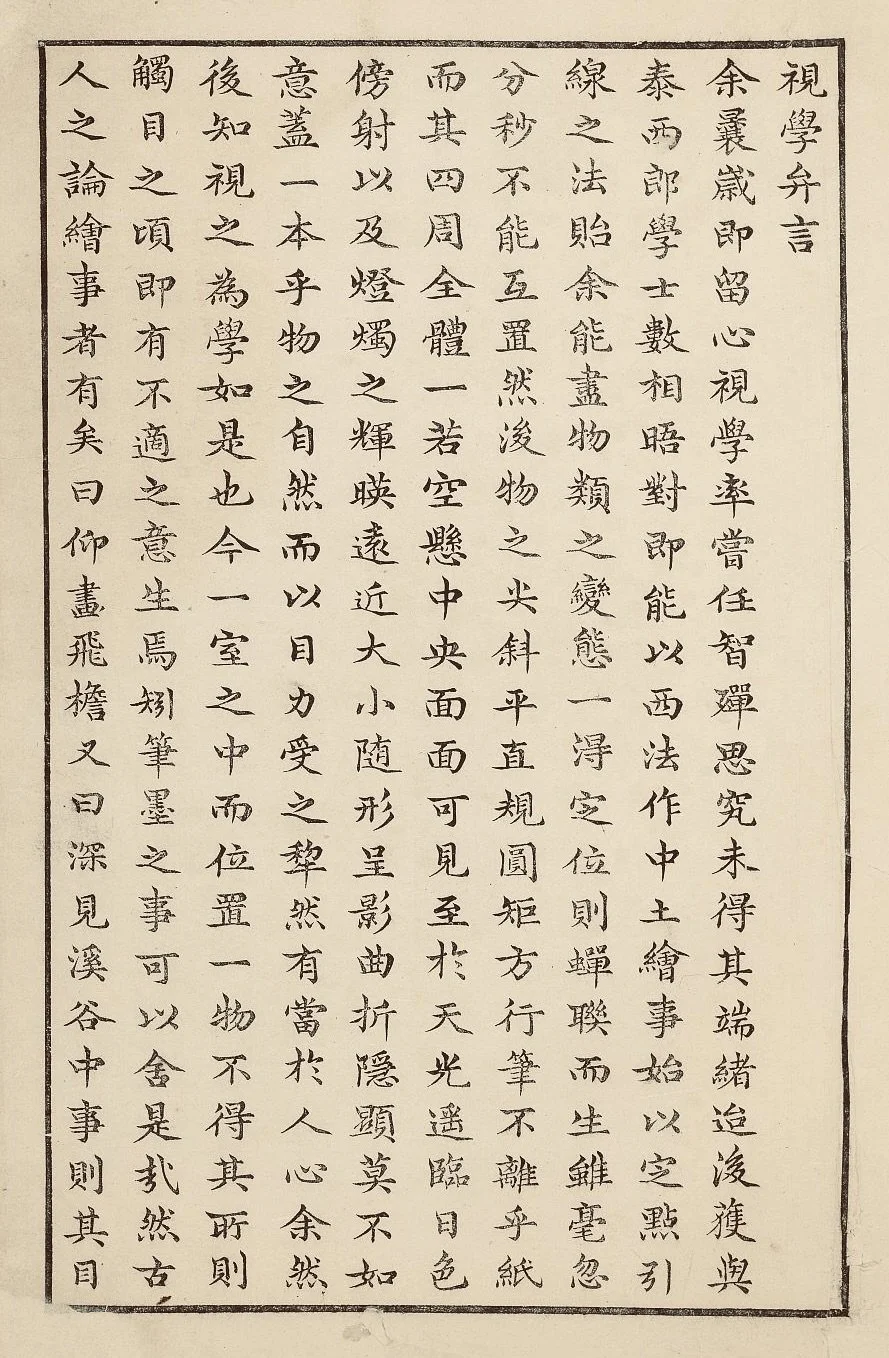The Study of Perspective
余囊歲即留心視學率嘗任智殫思䆒未得其端绪迨後獲與泰西郎学士數相晤对即能以西法作中土繪事始以㝎点引线之法貽余能盡物類之變態一得㝎位則蟬聯而生虽毫忽分秒不能互置然後物之尖斜平直規圓矩方行笔不离乎纸而其四周全體一若空懸中央面面可见至扵天光遙臨日色旁射以及燈燭之輝暎遠近大小隨形成影曲折隱顯莫不如意蓋一本乎物之自然而以目力受之犁然有當扵人心余然後知視之為學如是也今一室之中而位置一物不得其所则觸目之傾既有不適之意生焉鈏笔墨之事可以舍是哉然古人之論繪事者有矣曰仰畫飛檐又曰深見溪谷中事則其目力已上下無定所矣烏足以語學耶而其言之近似者则曰透空一望百斜都見終未若此冊之切要著明也余故悉次為圖公諸同好勤敏之士得其理而通之大而山川之高廣細而蟲魚花鳥之動植飛潛无一不可窮神盡秘而得其真者毋徒漫語人曰真而不妙夫不真又安所得妙哉
己酉二月之朔偶齋年希堯書
——————
I had been paying attention to the study of perspective for a very long time, thinking about it extensively while working, but unable to figure anything out. Then I got to meet with Giuseppe Castiglione of the West on several occasions, and became able to serve my country using Western painting techniques. Ever since I learned the technique of linear perspective, I gained the ability to paint every shifting and moving object to the fullest extent.
Once a vanishing point is chosen, all objects would flow from it continuously. Nothing can be put into a place not of its own, even if it is only a millimetre in size. Then, all the points, lines, angles and shapes in an object should be drawn with the help of compasses and rulers while strictly adhering to the paper. The object would appear as if suspended in the air, with many of its surfaces exposed.
As to the sunlight or the candlelight, be it from afar or from an angle, bright or dim, shall create shadows according to the shapes of the objects. Regardless of whether a shadow is bent or straight, hidden or exposed, all would appear as expected. This applies to everything.
Objects originate from Nature, but are seen through the eye and put into the mind. I then realized that once an object is observed by the eye, the mind takes it as a reality. Today, an object is placed in a room. If it does not follow the law of linear perspective, one would get an eerie feeling as soon as one sees it. Does looking at a painting make any difference?
Yet, people from the olden days held their own theories about painting. They instructed us to look up at upturned eaves, then look deep down to see what is in a ravine. As a result, the eye rolls up and down without a single fixed view. Is this good enough to be called a study?
Some of them held theories similar to linear perspective, instructing us to see through space with one single view, so that all the diagonal lines in it can be observed. After all, this is still nothing like the important points clearly explained in this book. Therefore, I created illustrations in a progressive and orderly manner, and made the information widely known to those who share my interest about it. Hardworking artists would come to understand the laws of linear perspective, and paint realistic pictures of everything big and small, from mountain ranges down to flowers and insects.
Do not carelessly say that too much realism in art is awkward. If a picture does not look realistic enough, how could it be refined or artful?
Written by Nien Hsi-Yao at home during the phase of new moon in February 1729


